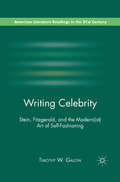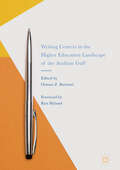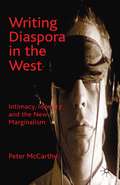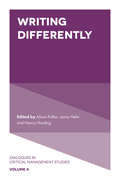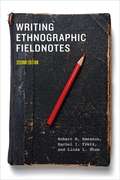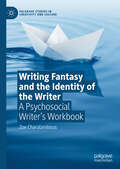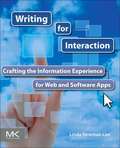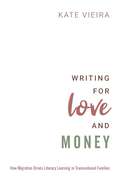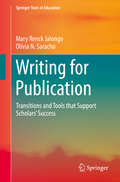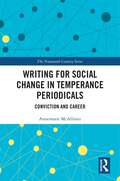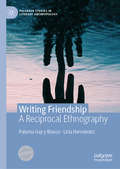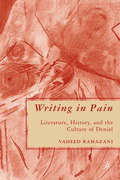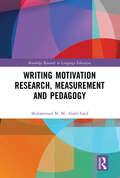- Table View
- List View
Writing Celebrity: Stein, Fitzgerald, and the Modern(ist) Art of Self-Fashioning (American Literature Readings in the 21st Century)
by T. GalowWriting Celebrity is divided into three major sections. The first part traces the rise of a national celebrity culture in the United States and examines the impact that this culture had on "literary" writing in the decades before World War II. The second two sections of the book demonstrate the relevance of celebrity for literary scholarship by re-evaluating the careers of two major American authors, F. Scott Fitzgerald and Gertrude Stein.
Writing Centers in the Higher Education Landscape of the Arabian Gulf
by Osman Z. BarnawiThis book addresses issues surrounding writing centers in the Arabian Gulf region. Including a foreword by Professor Ken Hyland, it brings together a number of thought-provoking chapters on the history, concept, and ground realities coupled with critical comparative discussions of writing centres in the region. The book begins by offering critical historical accounts of writing centers in the Gulf countries, before moving onto empirical research and reports on pedagogical practices that vividly capture the on-the-ground realities faced and experienced by different actors. These accounts serve to highlight how the writing centers vary between countries, as well as how they differ from the more well-known writing centers in the US and the UK. Finally, the book explores what sort of commonalities and differences the current trend of writing centres is producing within and between the six countries of the Arabian Gulf. This book will be highly relevant to those involved with writing centres along with directors, policymakers, researchers and teacher educators in the fields of Education and Sociology, particularly those with an interest in the Arabian Gulf area.
Writing Diaspora in the West: Intimacy, Identity and the New Marginalism
by P. McCarthyIn this bold intervention into the understanding of the diasporic experience within cultural studies, McCarthy challenges a critical position emergent over the last thirty years (what he calls the 'new marginalism'). He confronts the liberal orthodoxies that prevail in this area, exposing contradictions in the thinking of its major theorists.
Writing Differently (Dialogues in Critical Management Studies #4)
by Alison Pullen Jenny Helin Nancy HardingDespite a substantial body of work arguing for a new form of writing about management, organisations, workers, ourselves, and our lives, these calls are ironically made within the traditional scientific language. This volume of Dialogues in Critical Management Studies makes an important effort to facilitate the growth of a nascent movement to write differently and thus capitalise on the fruitful and creative margins which this opens up. Writing Differently is a critical, insightful, poetic and timely collection of essays, poems, plays and auto-ethnographic pieces that showcases the potential of academic writing. These texts reflect how writing is not always something we control or have agency over, demonstrate the multiple ways of expressions that are possible when we write about that which matters and exhibit the rich and varied forms of writing that emerge in the processes of being involved in scholarly work. The volume will be of interest to those interested in alternative ways of working, researching, thinking, organizing, writing research and research lives.
Writing Differently (Dialogues in Critical Management Studies #4)
by Alison Pullen Jenny Helin Nancy HardingDespite a substantial body of work arguing for a new form of writing about management, organisations, workers, ourselves, and our lives, these calls are ironically made within the traditional scientific language. This volume of Dialogues in Critical Management Studies makes an important effort to facilitate the growth of a nascent movement to write differently and thus capitalise on the fruitful and creative margins which this opens up. Writing Differently is a critical, insightful, poetic and timely collection of essays, poems, plays and auto-ethnographic pieces that showcases the potential of academic writing. These texts reflect how writing is not always something we control or have agency over, demonstrate the multiple ways of expressions that are possible when we write about that which matters and exhibit the rich and varied forms of writing that emerge in the processes of being involved in scholarly work. The volume will be of interest to those interested in alternative ways of working, researching, thinking, organizing, writing research and research lives.
Writing Ethnographic Fieldnotes, Second Edition (Chicago Guides to Writing, Editing, and Publishing)
by Robert M. Emerson Rachel I. Fretz Linda L. ShawIn Writing Ethnographic Fieldnotes, Robert M. Emerson, Rachel I. Fretz, and Linda L. Shaw present a series of guidelines, suggestions, and practical advice for creating useful fieldnotes in a variety of settings, demystifying a process that is often assumed to be intuitive and impossible to teach. Using actual unfinished notes as examples, the authors illustrate options for composing, reviewing, and working fieldnotes into finished texts. They discuss different organizational and descriptive strategies and show how transforming direct observations into vivid descriptions results not simply from good memory but from learning to envision scenes as written. A good ethnographer, they demonstrate, must learn to remember dialogue and movement like an actor, to see colors and shapes like a painter, and to sense moods and rhythms like a poet. This new edition reflects the extensive feedback the authors have received from students and instructors since the first edition was published in 1995. As a result, they have updated the race, class, and gender section, created new sections on coding programs and revising first drafts, and provided new examples of working notes. An essential tool for budding social scientists, the second edition of Writing Ethnographic Fieldnotes will be invaluable for a new generation of researchers entering the field.
Writing Ethnographic Fieldnotes, Second Edition (Chicago Guides to Writing, Editing, and Publishing)
by Robert M. Emerson Rachel I. Fretz Linda L. ShawIn Writing Ethnographic Fieldnotes, Robert M. Emerson, Rachel I. Fretz, and Linda L. Shaw present a series of guidelines, suggestions, and practical advice for creating useful fieldnotes in a variety of settings, demystifying a process that is often assumed to be intuitive and impossible to teach. Using actual unfinished notes as examples, the authors illustrate options for composing, reviewing, and working fieldnotes into finished texts. They discuss different organizational and descriptive strategies and show how transforming direct observations into vivid descriptions results not simply from good memory but from learning to envision scenes as written. A good ethnographer, they demonstrate, must learn to remember dialogue and movement like an actor, to see colors and shapes like a painter, and to sense moods and rhythms like a poet. This new edition reflects the extensive feedback the authors have received from students and instructors since the first edition was published in 1995. As a result, they have updated the race, class, and gender section, created new sections on coding programs and revising first drafts, and provided new examples of working notes. An essential tool for budding social scientists, the second edition of Writing Ethnographic Fieldnotes will be invaluable for a new generation of researchers entering the field.
Writing Ethnographic Fieldnotes, Second Edition (Chicago Guides to Writing, Editing, and Publishing)
by Robert M. Emerson Rachel I. Fretz Linda L. ShawIn Writing Ethnographic Fieldnotes, Robert M. Emerson, Rachel I. Fretz, and Linda L. Shaw present a series of guidelines, suggestions, and practical advice for creating useful fieldnotes in a variety of settings, demystifying a process that is often assumed to be intuitive and impossible to teach. Using actual unfinished notes as examples, the authors illustrate options for composing, reviewing, and working fieldnotes into finished texts. They discuss different organizational and descriptive strategies and show how transforming direct observations into vivid descriptions results not simply from good memory but from learning to envision scenes as written. A good ethnographer, they demonstrate, must learn to remember dialogue and movement like an actor, to see colors and shapes like a painter, and to sense moods and rhythms like a poet. This new edition reflects the extensive feedback the authors have received from students and instructors since the first edition was published in 1995. As a result, they have updated the race, class, and gender section, created new sections on coding programs and revising first drafts, and provided new examples of working notes. An essential tool for budding social scientists, the second edition of Writing Ethnographic Fieldnotes will be invaluable for a new generation of researchers entering the field.
Writing Ethnographic Fieldnotes, Second Edition (Chicago Guides to Writing, Editing, and Publishing)
by Robert M. Emerson Rachel I. Fretz Linda L. ShawIn Writing Ethnographic Fieldnotes, Robert M. Emerson, Rachel I. Fretz, and Linda L. Shaw present a series of guidelines, suggestions, and practical advice for creating useful fieldnotes in a variety of settings, demystifying a process that is often assumed to be intuitive and impossible to teach. Using actual unfinished notes as examples, the authors illustrate options for composing, reviewing, and working fieldnotes into finished texts. They discuss different organizational and descriptive strategies and show how transforming direct observations into vivid descriptions results not simply from good memory but from learning to envision scenes as written. A good ethnographer, they demonstrate, must learn to remember dialogue and movement like an actor, to see colors and shapes like a painter, and to sense moods and rhythms like a poet. This new edition reflects the extensive feedback the authors have received from students and instructors since the first edition was published in 1995. As a result, they have updated the race, class, and gender section, created new sections on coding programs and revising first drafts, and provided new examples of working notes. An essential tool for budding social scientists, the second edition of Writing Ethnographic Fieldnotes will be invaluable for a new generation of researchers entering the field.
Writing Fantasy and the Identity of the Writer: A Psychosocial Writer’s Workbook (Palgrave Studies in Creativity and Culture)
by Zoe CharalambousThis book presents the innovative pedagogy of Writing Fantasy: a method for exploring and shifting one’s identity as a writer. The book draws on qualitative research with undergraduate creative writing students and fills a gap in the literature exploring creative writing pedagogy and creative writing exercises. Based on the potential to shift writer identity through creative writing exercises and the common ground that these share with the stance of the Lacanian analyst, the author provides a set of guidelines, exercises and case studies to trace writing fantasy, evidenced in one’s creative writing texts and responses about creative writing. This innovative work offers fresh insights for scholars of creativity, Lacan and psychosocial studies, and a valuable new resource for students and teachers of creative writing.
Writing for Interaction: Crafting the Information Experience for Web and Software Apps
by Linda Newman LiorWriting for Interaction focuses on the art of creating the information experience as it appears within software and web applications, specifically in the form of user interface text. It also provides strategies for ensuring a consistent, positive information experience across a variety of delivery mechanisms, such as online help and social media. Throughout this book, you'll learn simple techniques for writing consistent text with the right tone, how to select content delivery mechanisms, and how straightforward, clear layouts help your customer interact with your application. Divided into five sections, the book completely covers the information experience design process from beginning to end. You'll cover everything from understanding your users and their needs, to creating personas, designing the IX strategy, creating your information, and evaluating the resulting information experience. This is your one-stop reference for information experience!Illuminates writing principles and practices for use in interactive design Includes examples, checklists, and sample processes, highlighting practical approaches to designing the information experience Provides the complete picture: understanding customer needs, creating personas, and writing the text appearing within the user interface
Writing for Love and Money: How Migration Drives Literacy Learning in Transnational Families
by Kate VieiraThis book tells the story of how families separated across borders write--and learn new ways of writing--in pursuit of love and money. According to the UN, 244 million people currently live outside their countries of birth. The human drama behind these numbers is that parents are often separated from children, brothers from sisters, lovers from each other. Migration, undertaken in response to problems of the wallet, also poses problems for the heart. Writing for Love and Money shows how families separated across borders turn to writing to address these problems. Based on research with transnational families in Latin America, Eastern Europe, and North America, it describes how people write to sustain meaningful relationships across distance and to better their often impoverished circumstances. Despite policy makers' concerns about "brain drain," the book reveals that immigrants' departures do not leave homelands wholly educationally hobbled. Instead, migration promotes experiences of literacy learning in transnational families as they write to reach the two life goals that globalization consistently threatens: economic solvency and familial intimacy.
WRITING FOR LOVE & MONEY C: How Migration Drives Literacy Learning in Transnational Families
by Kate VieiraThis book tells the story of how families separated across borders write--and learn new ways of writing--in pursuit of love and money. According to the UN, 244 million people currently live outside their countries of birth. The human drama behind these numbers is that parents are often separated from children, brothers from sisters, lovers from each other. Migration, undertaken in response to problems of the wallet, also poses problems for the heart. Writing for Love and Money shows how families separated across borders turn to writing to address these problems. Based on research with transnational families in Latin America, Eastern Europe, and North America, it describes how people write to sustain meaningful relationships across distance and to better their often impoverished circumstances. Despite policy makers' concerns about "brain drain," the book reveals that immigrants' departures do not leave homelands wholly educationally hobbled. Instead, migration promotes experiences of literacy learning in transnational families as they write to reach the two life goals that globalization consistently threatens: economic solvency and familial intimacy.
Writing for Publication: Transitions and Tools that Support Scholars’ Success (Springer Texts in Education)
by Mary Renck Jalongo Olivia N. SarachoThis book offers systematic instruction and evidence-based guidance to academic authors. It demystifies scholarly writing and helps build both confidence and skill in aspiring and experienced authors. The first part of the book focuses on the author’s role, writing’s risks and rewards, practical strategies for improving writing, and ethical issues. Part Two focuses on the most common writing tasks: conference proposals, practical articles, research articles, and books. Each chapter is replete with specific examples, templates to generate a first draft, and checklists or rubrics for self-evaluation. The final section of the book counsels graduate students and professors on selecting the most promising projects; generating multiple related, yet distinctive, publications from the same body of work; and using writing as a tool for professional development. Written by a team that represents outstanding teaching, award-winning writing, and extensive editorial experience, the book leads teacher/scholar/authors to replace the old “publish or perish” dictum with a different, growth-seeking orientation: publish and flourish.
Writing for Social Change in Temperance Periodicals: Conviction and Career (The Nineteenth Century Series)
by Annemarie McAllisterThis book suggests alternative ways of looking at what made a writer, what people gained from writing, and explores the alternative world of temperance periodicals of the nineteenth and early twentieth century. It introduces some of the now-forgotten writers who, in their thousands, kept the Victorian periodical presses rolling, and the public entertained. Locating their writing in the context of their personal commitment, the study takes seven prolific writers who were outside what we now think of as the circuits of conventional publication and authorship, and looks at how they found ways to make their voices heard. Their absorption in a cause led them to forge impressive writing careers in a variety of genres and media, focusing around high-circulation temperance periodicals. Examining their cultural contributions as well as their professional lives confirms the importance of the temperance movement in the second half of the nineteenth century, and raises questions about distribution practices and values, and distinctions between ‘life’ and ‘work.’
Writing for Social Change in Temperance Periodicals: Conviction and Career (The Nineteenth Century Series)
by Annemarie McAllisterThis book suggests alternative ways of looking at what made a writer, what people gained from writing, and explores the alternative world of temperance periodicals of the nineteenth and early twentieth century. It introduces some of the now-forgotten writers who, in their thousands, kept the Victorian periodical presses rolling, and the public entertained. Locating their writing in the context of their personal commitment, the study takes seven prolific writers who were outside what we now think of as the circuits of conventional publication and authorship, and looks at how they found ways to make their voices heard. Their absorption in a cause led them to forge impressive writing careers in a variety of genres and media, focusing around high-circulation temperance periodicals. Examining their cultural contributions as well as their professional lives confirms the importance of the temperance movement in the second half of the nineteenth century, and raises questions about distribution practices and values, and distinctions between ‘life’ and ‘work.’
Writing Friendship: A Reciprocal Ethnography (Palgrave Studies in Literary Anthropology)
by Paloma Gay y Blasco Liria HernándezThis book tells the remarkable story of the friendship between Liria Hernández, a Roma woman from Madrid, and Paloma Gay y Blasco, a non-Roma anthropologist. In this unique reciprocal experiment, the former informant returns the gaze to write about the anthropologist, her life and her environment. Through finely crafted and deeply moving text, Hernández and Gay y Blasco suggest new ways of doing and writing anthropology. The dialogue between Hernández and Gay y Blasco provides a courageous account of the entanglements and rewards of anthropological research. Drawing on letters, conversations, and fieldnotes gathered over twenty-five years, each of the authors talks about herself, the other, and the impact of anthropology on their two lives. They examine their intertwined trajectories as Spanish women and reflect on the challenges of devising their own reciprocal genre. Blending ethnography, life story and memoir, they undermine the dichotomy between author and subject around which scholarship still revolves.
Writing Gender, Writing Nation: Women’s Fiction in Post-Independence India
by Bharti AroraThis book explores the gendered contexts of the Indian nation through a rigorous analysis of selected women’s fiction ranging from diverse linguistic, geographical, caste, class, and regional contexts. Indian women’s writing across languages, texts, and contexts constitutes a unique narrative of the post-independence nation. This volume highlights the ways in which women writers negotiate the patriarchal biases embedded in the epistemological and institutional structures of the post-independence nation-state. It discusses works of famous Indian authors like Amrita Pritam, Jyotirmoyee Devi, Mannu Bhandari, Mahasweta Devi, Mridula Garg, Nayantara Sahgal, Indira Goswami, and Alka Saraogi, to name a few, and facilitates a pan-Indian understanding of the concerns taken up by these women writers. In doing so, it shows how ideas travel across regions and contribute towards building a thematic critique of the oppressive structures that breed the unequal relations between the margins and the centre. The volume will be of interest to scholars and researchers of gender studies, women’s studies, South Asian literature, political sociology, and political studies.
Writing Gender, Writing Nation: Women’s Fiction in Post-Independence India
by Bharti AroraThis book explores the gendered contexts of the Indian nation through a rigorous analysis of selected women’s fiction ranging from diverse linguistic, geographical, caste, class, and regional contexts. Indian women’s writing across languages, texts, and contexts constitutes a unique narrative of the post-independence nation. This volume highlights the ways in which women writers negotiate the patriarchal biases embedded in the epistemological and institutional structures of the post-independence nation-state. It discusses works of famous Indian authors like Amrita Pritam, Jyotirmoyee Devi, Mannu Bhandari, Mahasweta Devi, Mridula Garg, Nayantara Sahgal, Indira Goswami, and Alka Saraogi, to name a few, and facilitates a pan-Indian understanding of the concerns taken up by these women writers. In doing so, it shows how ideas travel across regions and contribute towards building a thematic critique of the oppressive structures that breed the unequal relations between the margins and the centre. The volume will be of interest to scholars and researchers of gender studies, women’s studies, South Asian literature, political sociology, and political studies.
Writing History from the Margins: African Americans and the Quest for Freedom
by Claire Parfait Hélène Le Dantec-Lowry Claire Bourhis-MariottiWith contributions from leading American and European scholars, this collection of original essays surveys the actors and the modes of writing history from the "margins" of society, focusing specifically on African Americans. Nearly 100 years after The Journal of Negro History was founded, this book assesses the legacy of the African American historians, mostly amateur historians initially, who wrote the history of their community between the 1830s and World War II. Subsequently, the growth of the civil rights movement further changed historical paradigms--and the place of African Americans and that of black writers in publishing and in the historical profession. Through slavery and segregation, self-educated and formally educated Blacks wrote works of history, often in order to inscribe African Americans within the main historical narrative of the nation, with a two-fold objective: to make African Americans proud of their past and to enable them to fight against white prejudice. Over the past decade, historians have turned to the study of these pioneers, but a number of issues remain to be considered. This anthology will contribute to answering several key questions concerning who published these books, and how were they distributed, read, and received. Little has been written concerning what they reveal about the construction of professional history in the nineteenth century when examined in relation to other writings by Euro-Americans working in an academic setting or as independent researchers.
Writing History from the Margins: African Americans and the Quest for Freedom
by Claire Parfait Hélène Le Dantec-Lowry Claire Bourhis-MariottiWith contributions from leading American and European scholars, this collection of original essays surveys the actors and the modes of writing history from the "margins" of society, focusing specifically on African Americans. Nearly 100 years after The Journal of Negro History was founded, this book assesses the legacy of the African American historians, mostly amateur historians initially, who wrote the history of their community between the 1830s and World War II. Subsequently, the growth of the civil rights movement further changed historical paradigms--and the place of African Americans and that of black writers in publishing and in the historical profession. Through slavery and segregation, self-educated and formally educated Blacks wrote works of history, often in order to inscribe African Americans within the main historical narrative of the nation, with a two-fold objective: to make African Americans proud of their past and to enable them to fight against white prejudice. Over the past decade, historians have turned to the study of these pioneers, but a number of issues remain to be considered. This anthology will contribute to answering several key questions concerning who published these books, and how were they distributed, read, and received. Little has been written concerning what they reveal about the construction of professional history in the nineteenth century when examined in relation to other writings by Euro-Americans working in an academic setting or as independent researchers.
Writing in Pain: Literature, History, and the Culture of Denial
by V. RamazaniThis book argues that while pain is an irreducible neuro-physiological phenomenon, how pain is experienced is powerfully inflected by language and culture. Using Second Empire France after Napoleon III's seizure of power as a particularly revealing time of re-acculturation, it elaborates on the "culture of denial."
Writing Labour: Stone Quarry Workers in Delhi
by Mohammad TalibIn most globalizing economies, workers engaged in the informal sector occupy the lowest rungs of society. This book examines one such group—stone quarry workers located beyond the expanding rim of south Delhi and beneath the radar of effective law and policy. Drawing upon extensive case studies and personal narratives of this labouring class, Talib focuses on their inner world and interprets their life stories. He records the dwindling oral tradition of these people and brings to the fore the dynamics of survival. Questioning the discourse that views this group as passive objects, the book portrays them as active negotiators of their own circumstances. This work is crucial to an understanding of the current debates on labour and development studies. It presents the workers' story of social exclusion and struggle for survival, which is rarely heard amidst the counter narratives of the formal sector's economic boom.
Writing Motivation Research, Measurement and Pedagogy (Routledge Research in Language Education)
by Muhammad M. Abdel LatifThis book provides a unique reference and comprehensive overview of the issues pertinent to conceptualizing, measuring, researching and nurturing writing motivation. Abdel Latif covers these theoretical, practical and research issues by drawing on the literature related to the eight main constructs of writing motivation: writing apprehension, attitude, anxiety, self-efficacy, self-concept, learning goals, perceived value of writing and motivational regulation. Specifically, the book covers the historical research developments of the field, the measures of the main writing motivation constructs, the correlates and sources of writing motivation, and profiles of motivated and demotivated writers. The book also describes the types of the instructional research of writing motivation, provides pedagogical guidelines and procedures for motivating students to write, and presents suggestions for advancing writing motivation research, measurement and pedagogy. Detailed, up-to-date, and with a glossary which includes definitions of the main terms used in the six chapters, this book will be of great interest to academics, researchers and post-graduate students in the fields of language education, applied linguistics, psycholinguistics and educational psychology.
Writing Motivation Research, Measurement and Pedagogy (Routledge Research in Language Education)
by Muhammad M. Abdel LatifThis book provides a unique reference and comprehensive overview of the issues pertinent to conceptualizing, measuring, researching and nurturing writing motivation. Abdel Latif covers these theoretical, practical and research issues by drawing on the literature related to the eight main constructs of writing motivation: writing apprehension, attitude, anxiety, self-efficacy, self-concept, learning goals, perceived value of writing and motivational regulation. Specifically, the book covers the historical research developments of the field, the measures of the main writing motivation constructs, the correlates and sources of writing motivation, and profiles of motivated and demotivated writers. The book also describes the types of the instructional research of writing motivation, provides pedagogical guidelines and procedures for motivating students to write, and presents suggestions for advancing writing motivation research, measurement and pedagogy. Detailed, up-to-date, and with a glossary which includes definitions of the main terms used in the six chapters, this book will be of great interest to academics, researchers and post-graduate students in the fields of language education, applied linguistics, psycholinguistics and educational psychology.
